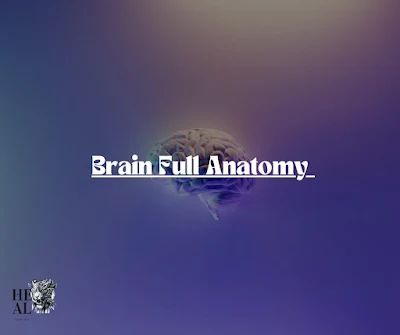Brain Full Anatomy
The brain is a remarkable, complex organ that governs everything we do—from thought and memory to emotions, motor skills, and every process that keeps our bodies functioning. Together with the spinal cord, the brain forms the central nervous system (CNS), a key player in regulating everything from breathing and temperature to hunger and movement.
 |
| Brain |
What is the Brain Made Of?
Weighing around three pounds in an adult, the brain is about 60% fat, while the remaining 40% consists of water, protein, carbohydrates, and salts. Despite common belief, the brain is not a muscle; instead, it's an intricate network of blood vessels, neurons, and glial cells. Neurons are responsible for communication within the mind, sending signals across the body, while glial cells support and protect them.
Gray Matter vs. White Matter
- Gray matter: This is the darker outer layer of the brain that primarily consists of neuron cell bodies (somas). It is responsible for processing and interpreting information.
- White matter: This is the lighter inner layer, made up of axons (the long extensions of neurons) wrapped in myelin, which transmits information throughout the central nervous system.
These two types of brain tissue work together, with gray matter processing data and white matter ensuring communication between different areas of the cerebrum and beyond.
How Does the Brain Function?
The brain sends and receives signals through a network of neurons, transmitting chemical and electrical impulses to control everything from sensations of tiredness to pain. Some signals are kept within the brain itself, while others travel through the spinal cord to distant parts of the body.
Main Parts of the Brain and Their Functions
Cerebrum: The largest part of the brain, responsible for initiating movement, regulating temperature, and enabling higher cognitive functions like speech, judgment, and problem-solving.
Brainstem: Connecting the cerebrum with the spinal cord, the brainstem manages essential survival functions, such as heart rate and breathing. It is composed of the midbrain, pons, and medulla.
Cerebellum: Located at the back of the head, the cerebellum controls voluntary movements and helps maintain balance and posture. Recent research also suggests it may play a role in emotions and cognitive functions.
Brain's Critical Functions
- Cognition: Thought, memory, and learning.
- Emotion: Mood regulation and stress response.
- Motor Skills: Coordination of muscles for movement.
- Sensory Processing: Interpreting information from sight, sound, and touch.
Lobes of the Brain
The brain is divided into four main lobes, each with its own vital functions:
- Frontal Lobe: Responsible for decision-making, personality, and voluntary movement.
- Parietal Lobe: Processes sensory information and spatial awareness.
- Temporal Lobe: Involved in memory, speech, and auditory information.
- Occipital Lobe: Primarily responsible for vision.
Brain’s Deeper Structures
- Pituitary Gland: Known as the "master gland," it regulates hormones that affect growth, metabolism, and reproductive functions.
- Amygdala: Plays a crucial role in emotional responses and memory.
- Hippocampus: Vital for forming new memories and spatial navigation.
The Brain and Cranial Nerves
The brain communicates with the rest of the body through 12 cranial nerves, which manage everything from smell and vision to movement and digestion.
Key Takeaways
- The brain works in harmony with the spinal cord, forming the central nervous system.
- It processes information through gray matter and communicates via white matter.
- Divided into distinct parts, the brain manages essential life functions, including emotion, cognition, and motor skills.
By understanding how this organ functions, we can appreciate its complexity and significance in maintaining our overall health and well-being.
